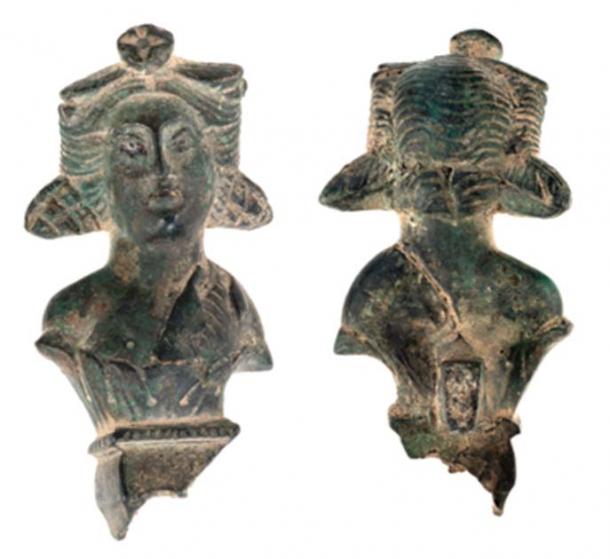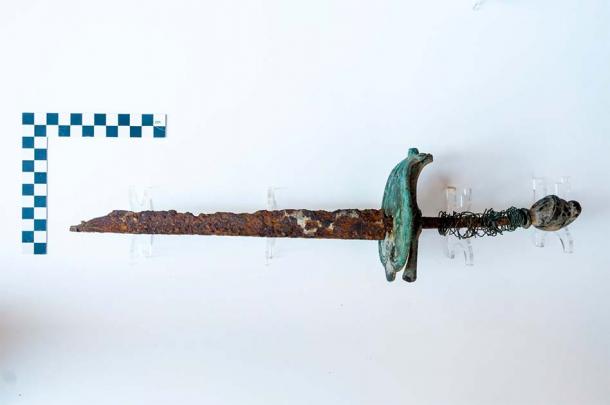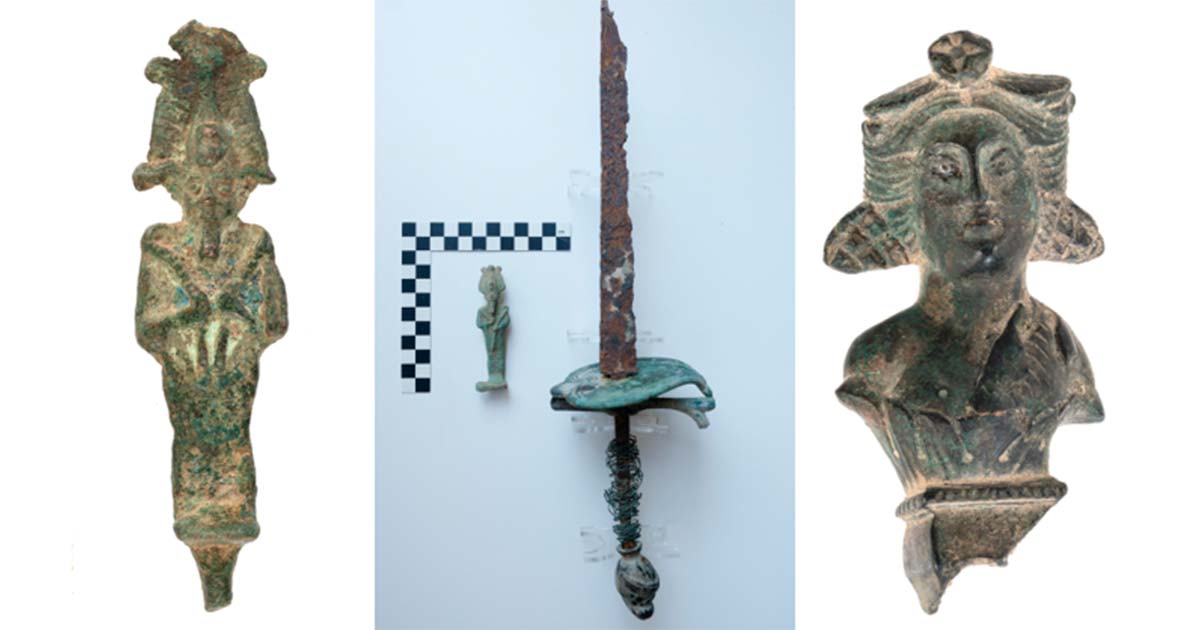Osiris Figurines and Bust of Bacchus Recovered Side by Side in Poland. Why?
In a recent archaeological excavation carried out in the village of Kluczkowice in Poland, a peculiar discovery has been made of Roman and Egyptian gods lying side by side. Two ancient Egyptian bronze figurines that depict the ancient Egyptian deity of fertility and agriculture, Osiris, from the 1st millennium BC. Next to these figurines was found a bust of Bacchus, the Roman god of wine, from the 1st century AD. These remarkable findings are described as "so unheard of in our area that it raised doubts as to the authenticity of these artifacts".
"It turned out that the figurines depicted the figure of Osiris, in the mythology of the Egyptian god of death and revived life, the great judge of the dead, and the bust of Bacchus – the Roman god of wine and vine, fertility, wild nature and fun,” said Krzysztof Kozłowski to Science in Poland (PAP).
So what is the explanation for them being found together at a dig site in Poland?

One of two Osiris figurines found at the site in Poland. (Łukasz Miechowicz/Lubelski Wojewódzki Konserwator Zabytków)
The Kleniewski Family: Residents of Kluczkowice Palace
The finds were believed to have once belonged to the Kleniewski family, who were residents of the Kluczkowice Palace until the German invasion of Poland during World War II. The discoveries actually occurred a year ago as a result of the collaborative efforts of the National Museum in Lublin and the Department of Archaeology at the University of Warsaw.
- Ancient Roman bronze figure of mythological Silenus found on Danish island
- Secrets of Roman Winemaking Revealed By Pollen-Charcoal Residue Analysis
The historical accounts found in Maria Kleniewska's diaries shed light on her travels to Egypt in 1904. She spent an extensive four months in Cairo and Alexandria, immersing herself in the rich cultural and historical heritage of the ancient land. During this time period, she is believed to have purchased the Osiris figurines. The second of these measures 8.5 cm (3.35 inches) and is equipped with two suspension wheels.
"We know from the memoirs and correspondence of Maria Kleniewska, which she even ran with the State Archaeological Museum in Warsaw, that she planned to create a chamber of antiquity in Kluczkowice, presenting monuments discovered in the region and purchased during the journey", Dr. Łukasz Miechowicz from the Institute of Archaeology and Ethnology of the Polish Academy of Sciences in Warsaw.
However, the fate of Maria after the war remains shrouded in mystery. Her husband had tragically lost his life during World War I, and her son, who inherited the estate, met a similar fate during World War II.
Researchers speculate that the Kleniewski family must have taken great pains to conceal these precious artifacts in an attempt to safeguard them from the clutches of the Nazi Secret Service and from the widespread looting and scattering of palace furnishings and collections that followed the war. However, in 1942, the family was evicted from the palace and their belongings confiscated and transferred to the SS. The statues mush have been buried to keep them safe, and have only been recovered last year.

Osiris statue (Łukasz Miechowicz /Lubelski Wojewódzki Konserwator Zabytków)
Authenticating and Assessing the Finds
To authenticate the findings, the two Osiris figurines were sent to the Voivodeship Office for the Protection of Monuments in Lublin. Experts at the office verified the identification of the figurines, confirming that they indeed depict Osiris, the revered ancient Egyptian god associated with fertility, agriculture, the afterlife, resurrection, and vegetation.
The third figurine that emerged, Bacchus, was renowned for being the Roman counterpart of the Greek Dionysus. He was known for his association with winemaking, orchards, fruit, vegetation, fertility, festivity, insanity, ritual madness, religious ecstasy, and theater. Essentially, Bacchus was a liberator from the painful shackles of everyday life, a divine being who prioritized pleasure.

Obverse and reverse of the Bacchus statue. (National Museum in Lublin/Lubelski Wojewódzki Konserwator Zabytków)
The Bacchus bust is believed to have been part of a tripod, resembling a similar discovery near Italy's Mount Vesuvius during the 18th century. It was discovered around 1906 by Fr. Antoni Chotynski, who was the chaplain of the Kleniewski family in Dratow (now Zagłoba/Wrzelów). They were from the grave of a wealthy deceased person, richly equipped, from the Przeworsk culture.
- Artifacts of War: Ancient Polish Weapons Found in Iron Age Graves
- Archeologists discover Mythical Tomb of Osiris, God of the Dead, in Egypt
Dr. Łukasz Miechowicz, an expert from the Institute of Archaeology and Ethnology of the Polish Academy of Sciences in Warsaw, emphasized the significance of recovering a portion of this long-lost collection. He stated, "The retrieval of a valuable collection lost many years ago holds great importance for the advancement of scientific knowledge, preservation of cultural heritage, and the potential for enhancing tourism."

17th century ceremonial sword found at the same site. (Łukasz Miechowicz /Lubelski Wojewódzki Konserwator Zabytków)
While unearthing these ancient relics, archaeologists also stumbled upon a fragment of a magnificently decorated ceremonial sword from the 17th century, reports The Heritage Daily. This sword represents a colichemarde, a popular short sword that first emerged in 1680 and enjoyed significant favor within European royal courts.
“The find, so unusual in our area, raised questions about the authenticity of the artifacts (…). Thanks to cooperation with the National Museum in Lublin and scientists from the Faculty of Archeology of the University of Warsaw, it was possible to confirm that these are original objects from Ancient Egypt and Ancient Rome,” concluded Miechowicz in a Facebook post.
Top image: Left to Right; Osiris statue, sword, Bacchus statue found at archaeological dig in Poland. Source: Lubelski Wojewódzki Konserwator Zabytków
By Sahir Pandey
References
Buyukyildurum, O. 2023. A surprising discovery in Lublin countryside! Ancient figurines of Egyptian and Roman gods found. Available at: https://arkeonews.net/a-surprising-discovery-in-lublin-countryside-ancient-figurines-of-egyptian-and-roman-gods-found/.
Markus, M. 2023. ANCIENT EGYPTIAN FIGURINES DEPICTING OSIRIS FOUND IN POLAND. Available at: https://www.heritagedaily.com/2023/05/ancient-egyptian-figurines-depicting-osiris-found-in-poland/147216.
Zdzieblowski, S. 2023. Lubelskie / Egyptian figurines of Osiris were discovered in Kluczkowice. Available at: https://naukawpolsce.pl/aktualnosci/news%2C96447%2Clubelskie-w-kluczkowicach-odkryto-egipskie-figurki-ozyrysa.html

















